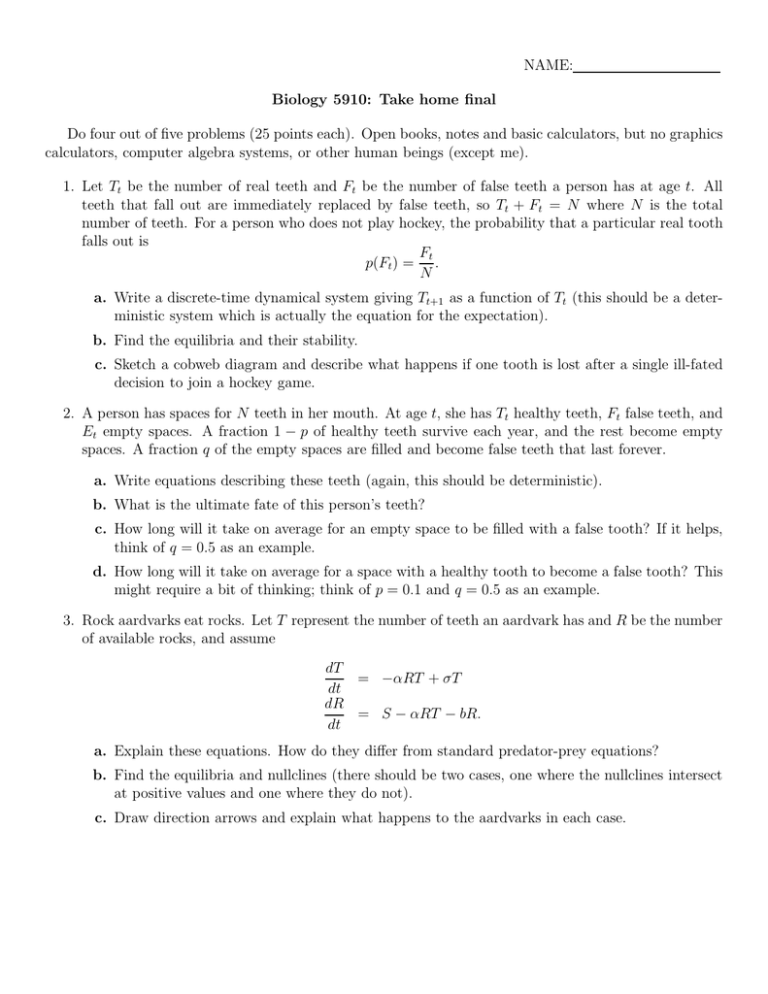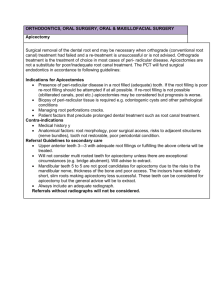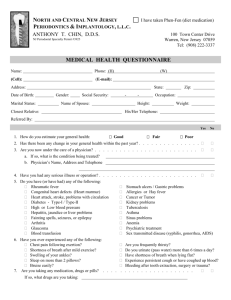NAME: Biology 5910: Take home final
advertisement

NAME: Biology 5910: Take home final Do four out of five problems (25 points each). Open books, notes and basic calculators, but no graphics calculators, computer algebra systems, or other human beings (except me). 1. Let Tt be the number of real teeth and Ft be the number of false teeth a person has at age t. All teeth that fall out are immediately replaced by false teeth, so Tt + Ft = N where N is the total number of teeth. For a person who does not play hockey, the probability that a particular real tooth falls out is Ft p(Ft ) = . N a. Write a discrete-time dynamical system giving Tt+1 as a function of Tt (this should be a deterministic system which is actually the equation for the expectation). b. Find the equilibria and their stability. c. Sketch a cobweb diagram and describe what happens if one tooth is lost after a single ill-fated decision to join a hockey game. 2. A person has spaces for N teeth in her mouth. At age t, she has Tt healthy teeth, Ft false teeth, and Et empty spaces. A fraction 1 − p of healthy teeth survive each year, and the rest become empty spaces. A fraction q of the empty spaces are filled and become false teeth that last forever. a. Write equations describing these teeth (again, this should be deterministic). b. What is the ultimate fate of this person’s teeth? c. How long will it take on average for an empty space to be filled with a false tooth? If it helps, think of q = 0.5 as an example. d. How long will it take on average for a space with a healthy tooth to become a false tooth? This might require a bit of thinking; think of p = 0.1 and q = 0.5 as an example. 3. Rock aardvarks eat rocks. Let T represent the number of teeth an aardvark has and R be the number of available rocks, and assume dT = −αRT + σT dt dR = S − αRT − bR. dt a. Explain these equations. How do they differ from standard predator-prey equations? b. Find the equilibria and nullclines (there should be two cases, one where the nullclines intersect at positive values and one where they do not). c. Draw direction arrows and explain what happens to the aardvarks in each case. 4. Over the course of 100 games, a left-handed hockey player loses teeth according to the following table. Suppose he started with 16 teeth on each side. Game 15 20 21 28 28 39 50 59 72 76 96 Side from which tooth lost Left Left Right Left Right Left Left Left Left Right Left a. Find maximum likelihood estimates for the probability a tooth is lost on the left side during the first 100 games, and the probability a tooth is lost on the right side during the same time. b. How would you go about convincing yourself that these values are different? c. Describe a method for estimating how long you would estimate it would take to lose all the teeth on each side. 5. Q is the energy invested in building and maintaining quality teeth and E is the energy used to chase food. An animal divides its total available energy R according to the constraint R = E + Q. a. Suppose that fitness W satisfies W = QE 2 . Find the optimal allocation to E and Q. b. Suppose that fitness depends on what sort of teeth the other animals have. In particular, an animal using the strategy (Q̂, Ê) against an animal with tooth hardness Q has fitness W = Ê 2 (Q̂ − Q). Find the best value of Q̂ as a function of Q. c. The previous part finds the best reply Q̂ as a function of Q. Find the value of Q which is a best reply to itself. What would happen to this population?






